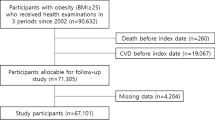Abstract
OBJECTIVE: Controversial data exist on the effect of obesity and weight reduction on surface electrocardiographic parameters. The purpose of this study was to analyze electrocardiograms of obese children in the course of short-term weight reduction. DESIGN: Prospective trial over a period of three weeks with a conventional low calorie diet containing a mean of 525±109 kcal. SUBJECTS: Thirty-three children, 17 girls and 16 boys with a mean age of 12.2±1.7 y and an overweight of 25.4–102%, mean 54.2±15.6%. MEASUREMENTS: Before the onset of therapy and thereafter, body weight, blood chemistry and 12 lead electrocardiographic evaluations were performed. RESULTS: The mean loss of body weight was 5.7±1.6 kg resulting in a mean decrease in overweight of 13.5±3.4%. Blood chemistry analyses revealed no significant changes except for cholesterol, triglycerides and uric acid. All electrocardiograms were within normal limits, however, a change in the electrocardiographic pattern was noted after weight loss. Heart rate (84±14 vs 64±11 beats per min, P<0.0001) and QT interval (418±20 msec vs 391±22 msec, P<0.0001) decreased and there was a tendency towards a rightward shift of the frontal plane QRS axis and a leftward shift of the horizontal plane QRS axis. CONCLUSION: Weight reduction in obese children and adolescents is associated with significant changes in the electrocardiographic pattern. These changes may only be detected by intraindividual comparison. Reduction of heart rate and shortening of the QT interval in the course of weight reduction may be of clinical significance by reducing the cardiovascular risk profile, including the risk of potentially fatal arrhythmias in obese subjects.
This is a preview of subscription content, access via your institution
Access options
Subscribe to this journal
Receive 12 print issues and online access
$259.00 per year
only $21.58 per issue
Buy this article
- Purchase on Springer Link
- Instant access to full article PDF
Prices may be subject to local taxes which are calculated during checkout
Similar content being viewed by others
Author information
Authors and Affiliations
Rights and permissions
About this article
Cite this article
Pidlich, J., Pfeffel, F., Zwiauer, K. et al. The effect of weight reduction on the surface electrocardiogram: A prospective trial in obese children and adolescents. Int J Obes 21, 1018–1023 (1997). https://doi.org/10.1038/sj.ijo.0800220
Received:
Revised:
Accepted:
Issue Date:
DOI: https://doi.org/10.1038/sj.ijo.0800220
Keywords
This article is cited by
-
Changes in serum interleukin-6 concentrations in obese children and adolescents during a weight reduction program
International Journal of Obesity (2001)



